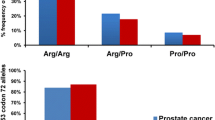Abstract
The aim of this study was to determine the prevalence of human papillomavirus (HPV) types in tissue and HPV antibodies in prostatic disease. Prostate tissue samples were collected from 51 patients diagnosed with adenocarcinoma and 11 with benign prostatic hyperplasia (BPH). All tissue samples were confirmed by histology. Plasma samples were available for 52 prostate patients. We investigated HPV DNA prevalence by PCR, and PCR positive samples were HPV type determined by sequencing. Prevalence of antibodies against twenty-seven HPV proteins from fourteen different HPV types was assessed in the plasma samples. The HPV DNA prevalence in the tissue samples was 14% (7/51) for prostate cancer samples and 27% (3/11) for BPHs. HPV-18 was the only type detected in tissue samples (10/62). No significant difference in HPV prevalence between the prostate cancer and BPH samples was found. HPV-positive cells were identified in eight of our thirteen prostate tissue slides (3/3 BPH and 5/10 adenocarcinoma) by in situ hybridisation, and the positive cells were found in epithelial cells and peripheral blood cells. Serology data showed no significant increase in levels of antibodies against any of the HPV-18 proteins tested for in prostatic disease patients. Antibodies against HPV-1, HPV-4, HPV-6 and HPV-11 were significantly higher in the group of males with prostatic disease. Our study did not show an association between prostatic disease and either presence of HPV DNA in samples or previous exposure of high-risk HPV.
Similar content being viewed by others
References
zur Hausen H (1996) Papillomavirus infections-a major cause of human cancers. Biochim Biophys Acta 1288:F55–F78
Effert PJ, Frye RA, Neubauer A, Liu ET, Walther PJ (1992) Human papillomavirus types 16 and 18 are not involved in human prostate carcinogenesis: analysis of archival human prostate cancer specimens by differential polymerase chain reaction. J Urol 147:192–196
Serth J, Panitz F, Paeslack U, Kuczyk MA, Jonas U (1999) Increased levels of human papillomavirus type 16 DNA in a subset of prostate cancers. Cancer Res 59:823–825
Zambrano A, Kalantari M, Simoneau A, Jensen JL, Villarreal LP (2002) Detection of human polyomaviruses and papillomaviruses in prostatic tissue reveals the prostate as a habitat for multiple viral infections. Prostate 53:263–276
McNicol PJ, Dodd JG (1991) High prevalence of human papillomavirus in prostate tissues. J Urol 145:850–853
Andersson S, Rylander E, Larson B, Sigurdardottir S, Backlund I, Sällström J, Wilander E (2003) Types of human papillomavirus revealed in cervical adenocarcinomas after DNA sequencing. Oncol Rep 10:175–179
Castellsague X, Diaz M, de Sanjose S, Munoz N, Herrero R, Franceschi S, Peeling RW, Ashley R, Smith JS, Snijders PJ, Meijer CJ, Bosch FX (2006) Worldwide human papillomavirus etiology of cervical adenocarcinoma and its cofactors: implications for screening and prevention. J Natl Cancer Inst 98:303–315
Mohan H, Bal A, Punia RP, Bawa AS (2003) Squamous cell carcinoma of the prostate. Int J Urol 10:114–116
Al-Maghrabi JA (2007) The role of human papillomavirus infection in prostate cancer. Saudi Med J 28:326–333
Dodd JG, Paraskevas M, McNicol PJ (1993) Detection of human papillomavirus 16 transcription in human prostate tissue. J Urol 149:400–402
Terris MK, Peehl DM (1997) Human papillomavirus detection by polymerase chain reaction in benign and malignant prostate tissue is dependent on the primer set utilized. Urology 50:150–156
Ruijter E, van de Kaa C, Miller G, Ruiter D, Debruyne F, Schalken J (1999) Molecular genetics and epidemiology of prostate carcinoma. Endocr Rev 20:22–45
Adami HO, Kuper H, Andersson SO, Bergström R, Dillner J (2003) Prostate cancer risk and serologic evidence of human papilloma virus infection: a population-based case-control study. Cancer Epidemiol Biomark Prev 12:872–875
Rosenblatt KA, Carter JJ, Iwasaki LM, Galloway DA, Stanford JL (2003) Serologic evidence of human papillomavirus 16 and 18 infections and risk of prostate cancer. Cancer Epidemiol Biomark Prev 12:763–768
Sutcliffe S, Viscidi RP, Till C, Goodman PJ, Hoque AM, Hsing AW, Thompson IM, Zenilman JM, De Marzo AM, Platz EA (2010) Human papillomavirus types 16, 18, and 31 serostatus and prostate cancer risk in the Prostate Cancer Prevention Trial. Cancer Epidemiol Biomark Prev 19:614–618
Forslund O, Antonsson A, Nordin P, Stenquist B, Hansson BG (1999) A broad range of human papillomavirus types detected with a general PCR method suitable for analysis of cutaneous tumours and normal skin. J Gen Virol 80:2437–2443
Waterboer T, Sehr P, Michael KM, Franceschi S, Nieland JD, Joos TO, Templin MF, Pawlita M (2005) Multiplex human papillomavirus serology based on in situ-purified glutathione s-transferase fusion proteins. Clin Chem 51:1845–1853
Michael KM, Waterboer T, Sehr P, Rother A, Reidel U, Boeing H, Bravo IG, Schlehofer J, Gartner BC, Pawlita M (2008) Seroprevalence of 34 human papillomavirus types in the German general population. PLoS Pathog 4:e1000091
Heideman DA, Waterboer T, Pawlita M, Delis-van Diemen P, Nindl I, Leijte JA, Bonfrer JM, Horenblas S, Meijer CJ, Snijders PJ (2007) Human papillomavirus-16 is the predominant type etiologically involved in penile squamous cell carcinoma. J Clin Oncol 25:4550–4556
Chen AC-H, McMillan NAJ, Antonsson A (2008) Human papillomavirus type spectrum in normal skin of individuals with or without a history of frequent sun exposure. J Gen Virol 89:2891–2897
Heng B, Glenn WK, Ye Y, Tran B, Delprado W, Lutze-Mann L, Whitaker NJ, Lawson JS (2009) Human papilloma virus is associated with breast cancer. Br J Cancer 101:1345–1350
Kan CY, Iacopetta BJ, Lawson JS, Whitaker NJ (2005) Identification of human papillomavirus DNA gene sequences in human breast cancer. Br J Cancer 93:946–948
Strickler HD, Goedert JJ (2001) Sexual behavior and evidence for an infectious cause of prostate cancer. Epidemiol Rev 23:144–151
Huang WY, Hayes R, Pfeiffer R, Viscidi RP, Lee FK, Wang YF, Reding D, Whitby D, Papp JR, Rabkin CS (2008) Sexually transmissible infections and prostate cancer risk. Cancer Epidemiol Biomark Prev 17:2374–2381
Acknowledgements
We would like to thank all patients for their participation in the study.
Conflicting Interests
None.
Funding
The Sir Edward Dunlop Medical Research Foundation, the Prostate Cancer Foundation in Australia and the Mazda Foundation.
Ethical approval
This project was approved by the Princess Alexandra Hospital Human Research Ethics Committee (PAH 2005/060).
Author information
Authors and Affiliations
Corresponding author
Rights and permissions
About this article
Cite this article
Chen, A.CH., Waterboer, T., Keleher, A. et al. Human Papillomavirus in Benign Prostatic Hyperplasia and Prostatic Adenocarcinoma Patients. Pathol. Oncol. Res. 17, 613–617 (2011). https://doi.org/10.1007/s12253-010-9357-4
Received:
Accepted:
Published:
Issue Date:
DOI: https://doi.org/10.1007/s12253-010-9357-4




